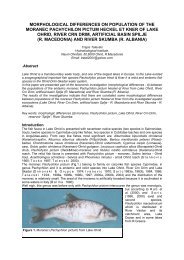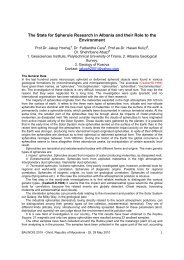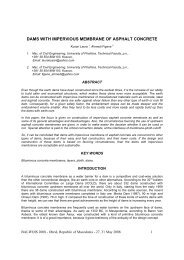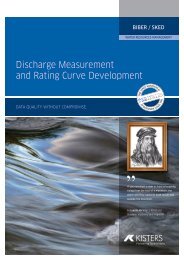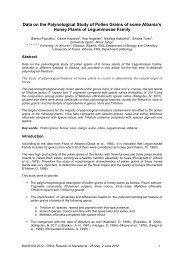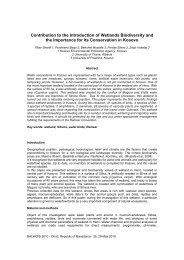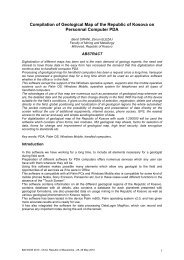Flora and Vegetation of Vlora Bay
Flora and Vegetation of Vlora Bay
Flora and Vegetation of Vlora Bay
Create successful ePaper yourself
Turn your PDF publications into a flip-book with our unique Google optimized e-Paper software.
The main issues <strong>of</strong> the study are:<br />
- Distinguishing flora <strong>and</strong> different spectrum <strong>of</strong> the area.<br />
- The determination <strong>of</strong> the main plants associations<br />
- Determination <strong>of</strong> the main structure <strong>of</strong> each association found with its data.<br />
- The environmental assessment <strong>and</strong> its impact on natural situation, highlighting the rare plants,<br />
with scientific <strong>and</strong> practical value.<br />
<strong>Flora</strong> <strong>and</strong> vegetation <strong>of</strong> an area are a great resource for national economic <strong>and</strong> scientific value.<br />
Therefore we try to find a definition on plants that are grown in our environment, in our case we have<br />
analyzed some <strong>of</strong> them in this study.<br />
Material <strong>and</strong> Methods<br />
<strong>Vlora</strong> is situated in a subtropical area with Mediterranean climate. This climate combines warm<br />
seawaters <strong>and</strong> fresh mountain air. Its mild climate, which gets even milder due to the special locations <strong>of</strong><br />
<strong>Vlora</strong> among high mountains next to the sea. <strong>Vlora</strong> <strong>Bay</strong> is located in eastern coast <strong>of</strong> the southeastern<br />
Adriatic Sea.<br />
Major roles in the floristic diversity <strong>of</strong> this area have Geomorphologic, climatic <strong>and</strong> environmental factors.<br />
This area has a high diversity <strong>of</strong> habitats. Mediterranean forests <strong>and</strong> shrubl<strong>and</strong>s represent a variety <strong>of</strong><br />
types, where are mentioned Pinus pinea, Erica arborea, etc. In shrubs are raised Quercus coccifera.<br />
S<strong>and</strong>banks area <strong>and</strong> coastal dunes consists <strong>of</strong> species such as, Eryngium maritimum <strong>and</strong> Inula<br />
crithmoides while rocky coastal areas consist <strong>of</strong> Sedum album, Ceterach <strong>of</strong>ficinarum, etc.<br />
As plants have an important role on living world, in this case study <strong>of</strong> plant associations <strong>and</strong> their relation<br />
with l<strong>and</strong>,climate, <strong>and</strong> enviromental factors have a great impact. Nowadays floristic studies have<br />
received several dimensions <strong>and</strong> deepening.What puts flora in danger in regional <strong>and</strong> world level is the<br />
reduction <strong>of</strong> plant, this dangerous phenomena reduce genetik fond <strong>of</strong> plants.( Ruci B., 1983)<br />
There are used two well-known methods to conduct this study: Physiognomic method <strong>and</strong> floristic<br />
method. (Xhulaj M., 2005: Buzo K., 2000)<br />
Physiognomic method is based on the outer morphological construction <strong>of</strong> plants cover <strong>and</strong> in the vital<br />
forms. According to this method, the plants are grouped in some forms, which are based on the height <strong>of</strong><br />
the vegetative buds from the earth surface.<br />
Floristic method based on the identification <strong>of</strong> plant species, which are present in their habitats. The<br />
process is divided in three phases: completing the surveys; evaluating <strong>of</strong> the plant species abundance –<br />
dominance; the determination <strong>of</strong> the species that were in the analyzed place. The determination is<br />
realized by identifying <strong>and</strong> nominating them using the appropriate literature. (Demiri M., 1983: Group <strong>of</strong><br />
Authors, 1988, 1992, 1996, 2000; Tutin T. G. etj., 1964-1980: Ruci B., 2000; Xhulaj M., Kashta L., 2003.)<br />
This study is conducted according to a methodology divided in three phases:<br />
a) Preparatory phase during this phase, there are gathered general data on the area as: physicalgeographical<br />
conditions, terrestrial <strong>and</strong> climatic conditions, <strong>and</strong> data on previous studies on this field. It is<br />
gathered all necessary materials <strong>and</strong> there are organized expeditions in the area.<br />
b) Field work phase (data collection in the field environment)<br />
This survey was carried in different seasons in the area. This was realized in order to obtain many<br />
fen<strong>of</strong>aze <strong>and</strong> different types <strong>of</strong> plants. We have made a complete description <strong>of</strong> the environment for each<br />
surveying parcels, <strong>and</strong> gathered other data such as scientific name <strong>of</strong> plant, geographic location <strong>and</strong> vital<br />
form for each type, etc., according to the respective methodologies.<br />
c) Laboratory phase (data processing in the laboratory or cabinet)<br />
In this phase, there are named the collected plants <strong>and</strong> their communities; realizing floristic <strong>and</strong> biological<br />
spectra.<br />
The study is illustrated with graphics, tables <strong>and</strong> photos.(Figure 9 – 33)<br />
BALWOIS 2012 - Ohrid, Republic <strong>of</strong> Macedonia - 28 May, 2 June 2012<br />
2



